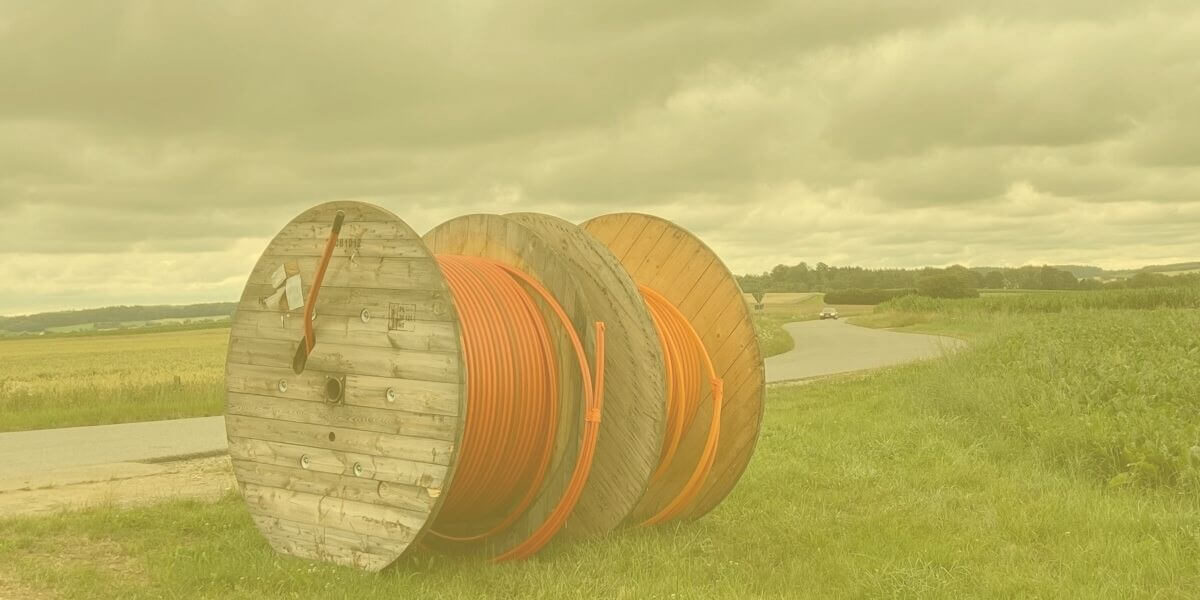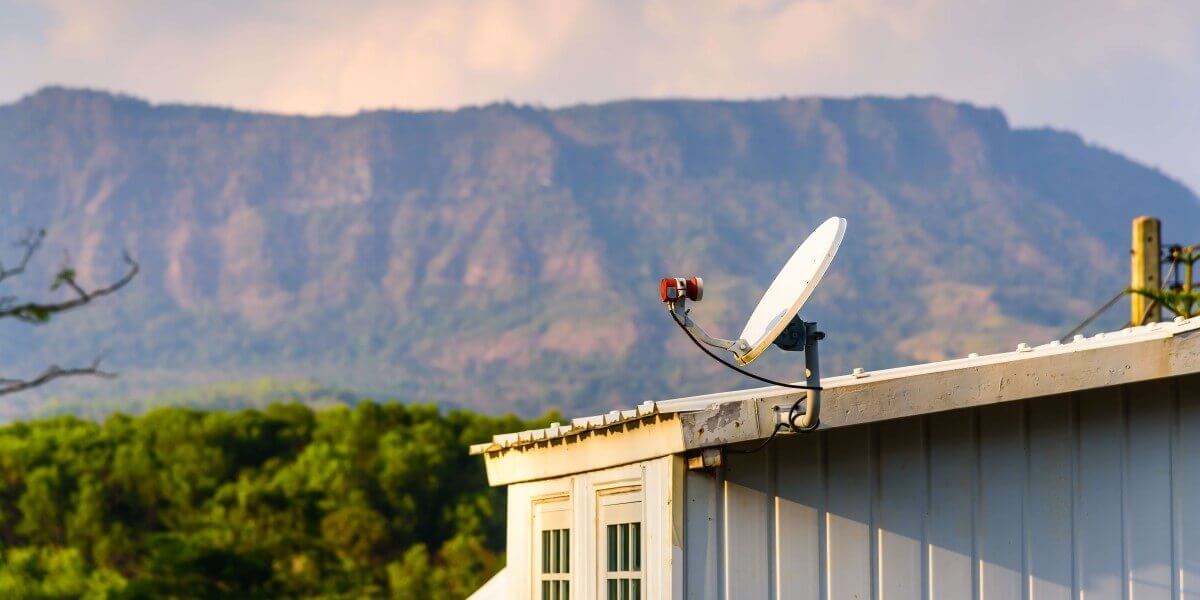Lower your internet bill
61% of people overpay for their internet.
Are you one of them?
Unlock exclusive offers in your area!
Call now
[tel]Enter zip code
1 Star is Poor & 5 Stars is Excellent.
* Required

Written by Rosslyn Elliott - Pub. Feb 07, 2022 / Updated Apr 02, 2024
Table of Contents
Are you happy with your Internet service?

About the author
If you live in a rural area, you know the joys of living close to nature. There’s room to breathe out in the countryside. The cost of living is usually cheaper, too. But one big challenge for country living is how to get internet in rural areas.
Internet service providers often don’t run cable or fiber-optic lines to less-populated places. That means your choices to get online are more limited. But don’t worry – there are still internet solutions for almost every rural home in the USA.
In this guide, we’ll explore why it’s a good idea to have high-speed internet in rural areas. Then we’ll show you all your options for home internet access, even if you don’t have cable or fiber.
One of the most important reasons to have high-speed internet is safety. Having multiple ways to communicate in case of emergency can be a lifesaver. In fact, broadband internet can be even more important during a crisis in a rural area than in a city. In a city, you can walk over to the next block to try to find help. In a rural area, you may be miles away from other people.
If you lose your cell phone or it stops working, your internet connection can be your reliable backup to contact family, the police, or an ambulance. That alone could be a valid reason to get internet. But there’s a lot more that the internet brings to rural residents in today’s world.
Despite all the advantages of rural life, it can sometimes get lonely. Using email and social media keeps millions of people connected to long-distance family and friends. Keeping in touch with old friends, your grandchildren, or your parents can be crucial to your happiness. The internet makes communicating much easier than it was in the days of phone cards and letters!
Being able to get online also opens up a world of entertainment options. Whether you prefer news, sports, movies, or chatting on group pages, you can find endless hours of reading and entertainment online. The internet becomes your bridge to the wider world. When you’re online, you can access many of the advantages of living in a city, but without the stress or expense.
Speaking of advantages, the internet now brings opportunities that didn’t even exist five years ago. Because of the boom in work-from-home positions, a reliable high-speed internet connection can be your meal ticket. Positions range from customer service paying $15 an hour to highly paid executive positions. The sky is the limit when it comes to remote work these days.
To get some of those jobs, you may want to advance your education in sought-after skills. The educational opportunity available through broadband can change your life. You can get a free low-cost professional certificate through many companies such as Hubspot or Coursera. Or, you can finish that degree you’ve always wanted through one of thousands of accredited universities online.
It’s hard to remember now what the world used to be like before the internet, but living in a rural area used to mean that your educational options were as limited as your job choices. That is happily no longer the case. Online, you can study anything and work almost anywhere, even from rural communities.
That’s why knowing your best internet options is crucial to your quality of life. You’ll want to know every type of rural broadband that is available at your home. There are more options than you might expect when it comes to how to get internet in rural areas.

DSL provides internet service across existing phone lines. Many internet companies first offered DSL back in the 1990s when it was the fastest technology. DSL was ten times faster than dial-up at that time. Now, though, DSL is much slower than newer technologies such as cable internet or fiber internet.
The companies that still offer most rural DSL internet are big internet service providers that have access to huge networks of phone lines. AT&T still has types of DSL, though they now call it IPBB, and much of their IPBB network is faster than the oldest DSL. Verizon and CenturyLink also are major providers of DSL.
DSL can vary from as slow as 1.4 Mbps download speeds to as fast as 15 Mbps. The average internet speeds for DSL tend to run around 6 Mbps download.
The quest for faster internet speeds is driving most rural providers away from DSL. Most internet providers want to focus on the newest internet technology with cable, fiber, and new breakthroughs in satellite internet.
DSL internet will offer a couple of advantages, if your only other option is dial-up service. The most important is that you can use your phone and the internet at the same time with DSL. But in general, unless you can get some of the faster IPBB connections, DSL will not be your best choice. The FCC defines broadband speeds as at least 25 Mbps download speed and 3 Mbps upload speed, and most DSL will seldom get to that standard.

As the newest, fastest internet technology, fiber infrastructure simply has not spread far enough to be a rural internet option.
Fiber signals travel down fiber optic lines that use pulses of light to send data. Internet providers are expanding their fiber service quickly, but it will be a long while before many rural areas get fiber internet connections. The major advantage of fiber is that unlike all older technologies, fiber has equal download speeds and upload speeds. All other types of internet connection have much faster speeds for downloads than for uploads.
In the past few years, the federal government has provided massive funding sources to help rural internet providers expand high-speed internet. The Rural Digital Opportunity Fund of 2020 earmarked over $20 billion to expand broadband networks in rural communities. Because rural internet providers are often interested in laying fiber lines, some of this federal funding may bring fiber to many more households in the next decade. But for now, rural internet options usually lack fiber.
Cable internet travels through the same cables used for cable television. Just like fiber, cable internet is often not available from from your rural internet provider. There’s a reason rural customers have watched satellite television for years! Cable TV lines were never installed in more remote areas of the country. Just like fiber lines, cable wires are most common in cities where there is high population density.
Cable is a worthy internet option with speeds increasing every day. Some cable internet providers can offer speeds of up to 1000 Mbps or 1 GBps, which is as fast as some fiber internet. But you just won’t find many cable internet providers in more remote rural areas.
Fixed wireless internet overcomes some common hurdles to rural internet service because it doesn’t require wires or cables. Instead, fixed wireless internet is broadcast from towers to a receiver at your home.
Fixed wireless can often be confused with cell phone service because both types broadcast from towers. You may wonder why fixed wireless is any better than using the data plan from your cell phone service.
The answer is that a fixed wireless connection has greater bandwidth and efficiency. The signals on high-end fixed wireless are not “sharing" airwaves with all the cellphones in your area. That means your fixed wireless internet service can provide higher speeds than your cellphone’s built-in hotspot, with download speeds averaging about 20 -50Mbps and upload speeds of 6-8 Mbps. Some fixed wireless connections even get as fast as 1000 Mbps download speeds, but that is rare.
Fixed wireless providers sometimes claim to offer unlimited data plans, and at times that may be true. At other times, when they claim to offer unlimited data plans, that means you do have a data allowance, but your internet won’t be cut off if you exceed that allowance. Once you exceed the limit, however, your internet speed will slow down considerably. You will not be able to do much except perhaps check email. This is the kind of data cap you may have experienced when using your cell phone as a hotspot. Because fixed wireless providers can vary so widely in their data plans, be sure you understand how your particular data plan would work.
The major downside to fixed wireless is that a broadcasting tower usually needs to be within 10 miles of your home. Many rural homes are not located within 10 miles of a fixed wireless tower. As a result, fixed wireless is one of the technologies that can’t provide coverage for many areas that need rural internet service.

Mobile broadband uses the same cellular network of radio towers that connects your smart phone to the internet.
Mobile broadband routers can be as small as a USB stick and can plug into your computer to give it a portable hotspot. Sometimes, dedicated portable routers can handle several devices at once. These routers have their own data SIM cards and their own data plans.
Why would you want to use a dedicated router or hotspot rather than the one that comes on your cell service? Basically, a cell phone was never designed to be a heavy duty hotspot, so using the cell phone as a hotspot will drain its battery very quickly. Cell phones also can’t handle multiple devices at once.
Mobile broadband is slower than fixed wireless because you share your mobile broadband connection with more users. Of course, mobile broadband also depends on being close enough to a tower to receive a signal.
In general, if you live in one rural area all year round, and you don’t need to move your internet access point from place to place, fixed wireless will be a better rural internet option for you than mobile broadband.
Satellite internet providers can get service to your home in almost any place in the USA. All you need is a clear view of the southern sky. Due to this superior coverage, satellite internet includes some of the best rural internet providers. The biggest satellite internet providers are Viasat, HughesNet, and Starlink.
Though satellite internet provides good coverage and reliability, there are a few things you should know if you are considering satellite for your rural internet options.
Satellite internet speeds do tend to be slower than cable or fiber speeds. Viasat provides the fastest geostationary satellite speeds at up to 150 Mbps, though speeds may vary by your location.
A satellite internet provider will have a system for granting you a certain amount of data each month. These data allowances are often called data caps. Your data cap will determine how much activity you are able to do on the internet. Emailing consumes almost no data compared to video streaming, which is a very high data activity.
With satellite internet, the types of data plan you get will vary from one satellite internet provider to another.
One more important thing you need to know if you are considering satellite for your rural internet services is that satellite connections are affected by latency. Latency is a small delay or lag that happens when a signal has to cross a long distance before it reaches your computer. For most internet activities, latency’s delay is too small to notice. But high latency will make a difference in real-time gaming and videoconferencing.

Now that you know the basics about the types of internet connections that might be available to you in rural areas, let’s recap. There are several major factors that will help you choose the best rural internet provider for you.
Which kinds of internet connections are available for you at your home? Can you get a wired connection such as DSL, cable or fiber? If not, what are your wireless or satellite internet options? In rural areas, you may have fewer options than you would in a more populated area. But you will still have satellite internet options, and you might have a few other options from the list above.
How fast will your connection be for download speeds and upload speeds? If you plan to stream video, you will probably want a minimum of standard broadband speed, that is, 25 Mbps download speed/3 Mbps upload speed. Wired connections usually provide faster speeds. Be aware, though, that depending on your infrastructure, even your best rural DSL internet may be slower than satellite internet.
Data caps are any limits that providers place on your use of data. Some ISPS offer unlimited data, and charge you only by your internet speed (usually wired internet providers). Other internet providers have data limits and will charge you overage fees if you exceed your limits.
Some wireless and satellite providers claim to offer unlimited data, but actually use soft data caps. A soft data cap means that you have a certain data allowance each month. When you exceed that allowance, your internet speed will slow down so much that you will be limited to only a few activities such as checking email.
Viasat is a strong pick for best overall rural internet provider when you consider four factors: coverage, speed, data caps, and price. For availability, nothing beats satellite internet coverage, which is available to almost anyone in the nation. And Viasat beats out the other major satellite providers with its combination of affordability, data capacity, and reliability.
Viasat offers the fastest speeds from any geostationary satellite internet provider. You can get speeds up to 150 Mbps depending on your location. Viasat plans also offer unlimited Standard Data, so you will never face unexpected monthly charges. And Viasat also offers the highest levels of High-Speed Data, so you can stream easily. If you find you need more high-speed data at the end of the month, Viasat makes it simple to purchase data tokens to expand your monthly allowance temporarily.
Satellite internet does tend to be more expensive across the board than first-tier wired internet plans. Compared to HughesNet and Starlink, Viasat offers better prices for the speed you will get.

The best rural internet options for RVs will vary depending on how much you move around during the year. If you are an RV full-timer who spends all year in rural or remote areas, and you don’t have any wired or wireless options, then you may still go for a portable satellite package.
Another great internet option for RV living is 4G mobile broadband. The mobile broadband connection will be faster, though somewhat less reliable than satellite. You will lose signal when you move out of the range of cellular towers. But you can use mobile broadband while you are in motion, where most satellite dishes must be stationary. To choose from the best rural internet providers for your RV, consider where you travel and whether you are frequently out of range of cellular service.
Internet service is expensive, and the U.S. government has recognized that this expense can be a barrier to opportunity. Qualifying households can receive support of up to $30/month on their internet expenses. To discover more about whether you qualify for the program, check out the Affordable Connectivity Program website from the FCC.
Any internet service that requires laying cable or fiber optic line becomes a big investment. A crew has to travel for miles, digging and laying cable the whole way. Think of how expensive it would be to lay ten miles of cable for a single home out in a rural area. By contrast, if an ISP lays that same cable in a city, there will be thousands of potential customers who pay them back for their investment.
If you are currently using a cellular service and the signal arriving at your router is not strong enough, you can use equipment such as a cellular signal booster to strengthen your signal. If you are receiving a decent signal to the router in your house, but you lose your signal in different places in the house, a Wi-Fi booster or extender might be your answer.
Yes, internet access in rural areas is likely to improve significantly over the next ten years. Over $20 billion allocated by the Rural Opportunity Fund will pay for more wired infrastructure to develop in rural areas. The federal government will subsidize the necessary infrastructure in order to help more people get high-speed internet.
There are a very few places without any service in rural areas, but they are rare. Even when it seems as if there is no internet in your area, satellite will almost always cover you. All that is necessary to get satellite internet is a clear view of the southern sky. Most satellite companies require professional installation, so an expert can help you get the best signal despite any partial obstructions to your sky view.
5G faces some of the same challenges as fiber internet when it comes to infrastructure in rural areas. 5G signals travel through the millimeter Wave (mmWave) range, which means 5G signals can’t travel as far as 4G signals. That means 5G towers must be built closer together. Though 5G can bring incredible bandwidth, the spacing of 5G towers makes 5G more expensive to build out than 4G. Government support for broadband in rural areas may help 5G expand, but it will be a gradual process.
It is possible to create hybrid networks that combine 5G and 4G towers. But blending the two network types will reduce the potential speeds of 5G technology.


About the author
Congratulations, you qualify for deals on internet plans.
Speak with our specialists to access all local discounts and limited time offers in your area.
[tel]61% of people overpay for their internet.
Are you one of them?
Unlock exclusive offers in your area!
Call now
[tel]Enter zip code